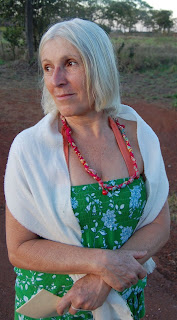The children with plant names were fidgeting around their home in Chapada dos Guimaraes when I emerged from the thick greenery.
It was 1991; my nephew, Haloa (whose name means Field of Flowers in the native Indian language Tupi-Guarani), was then 2. He was outside splattering mud up to his neck. Inside the house, my niece, Iuca, (Manioc Root in Spanish), 5, was tugging at her mother’s skirt. My niece, Lotus, 8, ran to hug me.Cida’s other children, not my nephews, were Ginseng, then 12, and the howling infant Caiubi (Blue Leaves in Tupi-Guarani.)
In spite of the commotion, their mother, Cida, seemed relaxed. My arrival after three years was a surprise, but she greeted me casually, “Oi, tudo bem?” (Hi…everything all right ?)
Cida bore three more children during the next 10 years, Radharani ( wife of Krishna, Completeness in Sanskrit ), Iasmim (Jasmine), and Hermano (Brother in Spanish). She would have had nine children, but she lost one when a snake bit her during pregnancy. So, she only had eight.
 |
| Cida makes music with grandchild Isabela. Behind them: Radharani |
Then I stopped visiting Chapada. My brother, Mike, had separated from Cida (before 1991), and their three children eventually went to live with him and go to school in Sao Paulo.
Now after more than 20 years, I finally visited Chapada. Cida, 56 (photo, top right), still lives in the small wooden house built by Mike about 30 years ago when he was 18.
Fruit trees fertilized with his children’s placenta still grow in the front yard near woods full of monkeys and coatis. A river flows about half a kilometer behind the house. Using buckets of water he fetched from that river, Mike had delivered two of his children.
As always, Cida (short for Maria Aparecida ) cooks by wood fire. She has had running water for many years, and electricity became available in her area several years ago. A sign that says “seamstress” and another that advertises “whole grain bread baked by wood fire” hang on her fence by the deep green road ( see photo, previous post).
After relationships with the three fathers of her children, Cida says she chooses to be alone, with God only. She attends a group that uses mantras and prayers as “a way to go inside yourself.” Her spiritual practice seems to mix vegetarianism, reincarnation, Jesus, and more.
Some of her “alternative community” neighbors from the 1980s continue to live on her road, including Jorge in the Indian hut (see previous post). Nearby, another old-timer, Helio, still spends his nights in a hammock on the porch of his brick house (photo below). Since he sleeps outdoors, he says, “I don’t even know why I have a house.”
His rustic kitchen has a view of the woods (photo above, Helio in foreground ); there he talks about running away from home about 30 years ago the day he was scheduled to register for college in the city of Recife.
Now he makes a good living as a specialized guide who leads people to wild animals in the nearby Pantanal, one of the world’s largest wetlands.
He complains about deforestation in Chapada. Vacation homes have been sprouting around him for two decades. Less than a mile away, the high walls of gated communities, Condominio Jamaca Village I and II, jut out of the woods like an urban nightmare.
Another city dropout from his era, Mario, keeps a home in Chapada, made of hand-made bricks. However, during recent years he has been living in the wilder west of Vila Bela da Santissima Trindadade near the Bolivian border.
When Mario, now 51, arrived in Chapada about 30 years ago, he stayed very close to the animals he was photographing. He lived in a one-room hut deep inside the woods near the waterfall on his property (photo, top of post, right). It serves as the neighborhood pool.
Now an established photographer, Mario Friedlander posts wlidlife and scenery shots on his facebook page. He also puts links for petitions to save the Amazon.
During my visit to Chapada, Mario was in town taking pictures of Chapada’s winter music festival for the municipal government, which now presides over a population of more than 17,000.
In that municipality, the dropouts of the 1980s have left imprints (see upcoming story, Part 3). However, Mario insists with a tone of utter disgust: “This has turned into a place for the bourgeois.”
Story and photos by Carola C. Reuben, Earthy Reporter, copyright 2011
TO BE CONTINUED SOON...PART 2 OF A 3 PART STORY
earthyreporter@aol.com





I enjoyed the photos, and the descriptions of the changes since your last visit in Brazil's wild east(?), and the stories of people wanting to get away from "so-called" civilization, apparently without much success. felix
ReplyDeleteThe city dropouts still live in a paradise. However, they no longer have it all to themselves. So...I would give it a 50-50 success rate at the very least; after all, their major goal was leaving urban lifestyles.
ReplyDeleteIt is the Wild West, not the east; it is near the Bolivian border.
lindooooooo
ReplyDelete